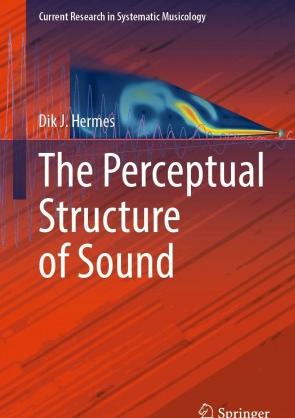The Perceptual Structure of Sound
Soft / Music Magazines
13-06-2023

This book presents a comprehensive review of how acoustic waves are processed by the auditory system into structured sounds such as musical melodies, speech utterances, or environmental sounds. After an introduction, an overview is given of how the ears distribute acoustic information over a large array of frequency channels that contain the auditory information used by the central nervous system to generate a mental image of what is happening around the listener.
This process, called auditory scene analysis, consists of two stages. In the first stage, auditory units are formed such as musical tones and speech syllables. Each auditory unit is perceived at a well-defined moment in time, the beat location of that auditory unit. Moreover, from this process of auditory-unit formation, the auditory attributes of these auditory units emerge, such as their timbre, their pitch, their loudness, and their perceived location. Each of these attributes is discussed in the corresponding chapter.
In the second stage of auditory scene analysis, auditory-stream formation, the successive auditory units are integrated into auditory streams, i.e., temporally structured sequences of auditory units that are perceived as emanating from one and the same sound source.
Examples of such auditory streams are musical melodies and the utterances of one speaker. The temporal structure of an auditory stream, its rhythm, is determined by the beat locations of its auditory units. The role played by the auditory attributes of the consecutive auditory units is discussed. The melodies of musical streams and the intonation contours of spoken utterances emerge from this process. In music, the beats of parallel streams generally fit into a metric pattern, and, depending on harmony, simultaneous tones can be perceived as consonant or dissonant.
Finally, the book contains many sound examples including the MATLAB scripts with which they are generated.
home page:
https://goo.su/FHIlh
This process, called auditory scene analysis, consists of two stages. In the first stage, auditory units are formed such as musical tones and speech syllables. Each auditory unit is perceived at a well-defined moment in time, the beat location of that auditory unit. Moreover, from this process of auditory-unit formation, the auditory attributes of these auditory units emerge, such as their timbre, their pitch, their loudness, and their perceived location. Each of these attributes is discussed in the corresponding chapter.
In the second stage of auditory scene analysis, auditory-stream formation, the successive auditory units are integrated into auditory streams, i.e., temporally structured sequences of auditory units that are perceived as emanating from one and the same sound source.
Examples of such auditory streams are musical melodies and the utterances of one speaker. The temporal structure of an auditory stream, its rhythm, is determined by the beat locations of its auditory units. The role played by the auditory attributes of the consecutive auditory units is discussed. The melodies of musical streams and the intonation contours of spoken utterances emerge from this process. In music, the beats of parallel streams generally fit into a metric pattern, and, depending on harmony, simultaneous tones can be perceived as consonant or dissonant.
Finally, the book contains many sound examples including the MATLAB scripts with which they are generated.
home page:
https://goo.su/FHIlh
Related articles
Soft / Music Magazines
4-08-2022
The Auditory System and Human Sound-Localization Behavior provides a comprehensive account of the full action-perception cycle underlying spatial hearing. It highlights the interesting properties of the auditory system, such as its organization in azimuth and elevation coordinates.
Soft / Music Magazines
11-06-2022
Auditory Interfaces explores how human-computer interactions can be significantly enhanced through the improved use of the audio channel.
Providing historical, theoretical and practical perspectives, the book begins with an introductory overview, before presenting cutting-edge research with chapters on embodied music recognition, nonspeech audio, and user interfaces.
This book will be of interest to advanced students, researchers and professionals working in a range of fields, from audio sound systems, to human-computer interaction and computer science.
Soft / Music Magazines
9-01-2022
The electronic medium allows any audible sound to be contextualized as music. This brings about unique structural possibilities as spectrum, dynamics, space, and time become continuous dimensions of musical articulation. What we hear in electronic music ventures beyond what we traditionally characterize as musical sound and challenge our auditory perception on the one hand and our imagination on the other. Based on an extensive listening study conducted over four years, this book offers a comprehensive analysis of the cognitive processes involved in the experience of electronic music.
Soft / Music Magazines
12-07-2021
The Auditory Setting introduces and investigates how narrative and a sense of place are constructed in film and media arts through the reproduction and mediation of site-specific environmental sounds, or ‘ambience’. Although this sonic backdrop acts as the acoustically mediated space where a story or event can take place, there has been little academic study of sound’s undervalued role in cinematic setting and production. Drawing on theories of narrative, diegesis, mimesis and presence, and following a varied number of relevant audio-visual works, this book is a ground-breaking exploration of human agency in mediating environmental sounds and the nature of the sonic experience in the Anthropocene.